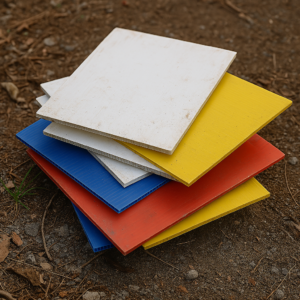
In a world where attention spans are short and competition for visibility is high, signage has become a key player in marketing, politics, events, and even protests. Among the many materials used for temporary signs, corflutes stand out for their cost-effectiveness, lightweight durability, and vibrant print quality. But as society becomes more environmentally conscious, an important question arises—how sustainable are corflutes really?
With the urgency around climate change and consumer waste at an all-time high, it’s worth examining whether corflutes are eco-heroes due to their longevity and reusability, or silent contributors to plastic pollution.
What Are Corflutes and Why Are They So Popular?
Corflutes, technically known as corrugated polypropylene boards, are a type of rigid plastic often used for short-term signage. You’ll spot them everywhere—from real estate boards and construction site notices to political campaign posters and event directionals.
Their appeal lies in their adaptability. Corflutes are lightweight, weather-resistant, and provide a clean, high-resolution surface for printing. This makes them ideal for both indoor and outdoor use. Plus, their relative affordability means businesses, event organisers, and individuals alike turn to them for all kinds of messaging needs.
For example, in Australia, many local printers offer custom corflute signage with fast turnaround times. One such provider, Corflutes – Just Click Print, delivers durable, customisable signs suited to various applications—from safety notices to retail displays.
Yet with this widespread use comes increased scrutiny. What happens to all these signs once the campaign, sale, or event ends?
The Lifecycle of a Corflute Sign
From a material standpoint, corflutes are made from polypropylene, a thermoplastic polymer. It’s widely used in packaging and textiles because of its strong yet flexible properties. While it’s technically recyclable, its actual recycling rate is relatively low, particularly when it’s been printed with UV ink or exposed to outdoor elements.
Corflutes don’t decompose naturally, so when they end up in landfills, they contribute to the growing volume of long-lasting plastic waste. According to various environmental studies, polypropylene can take hundreds of years to break down.
That said, corflutes can be reused—if collected and stored properly. However, many businesses and event planners opt for the convenience of single-use applications. The result? A significant volume of signage waste after short-lived campaigns.
For readers interested in broader discussions about plastic waste and sustainability, The Dark Side of Plastics: How Recycling Isn’t Always the Answer offers a deep dive into why recycling isn’t always the magical solution it appears to be.
Creative Reuse and Community Solutions
Despite the issues around recycling, corflutes can be repurposed in clever and impactful ways. Community groups, schools, and hobbyists often take used corflutes and convert them into stencils, art canvases, garden bed liners, or even storage box dividers.
In some areas, local councils collect corflutes for recycling, while innovative companies are beginning to offer take-back schemes to reuse or upcycle the material. However, these options are still limited in scale and availability.
If you’re planning a temporary campaign, consider designing your signage with reuse in mind. Neutral, non-date-specific designs make signs easier to repurpose. Using velcro or stickers for changing details also helps extend the lifespan of each board.
Are There Eco-Friendly Alternatives to Corflutes?
There are biodegradable signage options, such as cardboard-based signs or fibreboard alternatives. These materials break down more easily and are typically made from recycled paper or wood pulp. However, they tend to be less durable, especially when exposed to weather.
For high-traffic areas or outdoor applications, these greener options may not hold up as well. The durability of corflutes often outweighs the short-term environmental benefit of biodegradable materials—particularly when signs need to remain legible and intact for weeks or even months.
So the choice becomes more nuanced. It’s not always about which product has the smallest environmental footprint on paper. Sometimes it’s about how long that product can be reused and whether it actually ends up in landfill or gets repurposed.
You can explore broader themes on ethical consumption and global environmental choices in The Impact of Consumerism on the Planet, another excellent resource that examines everyday decisions and their wider ecological consequences.
Finding the Middle Ground: Practical Sustainability
For businesses and individuals aiming to reduce their environmental footprint without compromising on quality, the answer may lie in responsible sourcing and strategic usage. When chosen wisely, corflutes can be part of a low-impact marketing strategy:
- Buy local: Reduce emissions from transport.
- Design for longevity: Avoid date-specific content so signs can be reused.
- Recycle responsibly: Contact your local council or signage supplier for advice.
- Store with care: Protect corflutes after use to maximise reuse potential.
It’s also important to work with printers who understand sustainable practices. Providers like Corflutes – Just Click Print offer insights into material quality, durability, and responsible production processes, helping you make more informed decisions.
Conclusion: Echoing Smarter Choices
Corflutes may never be the greenest signage material on the market, but they’re not necessarily the worst offender either—especially when reused effectively. The key lies in how they’re made, used, and discarded.
Like many modern materials, corflutes exist in a grey area of convenience versus consciousness. Rather than demonise or glorify them, it’s more useful to acknowledge their role and make smarter, more deliberate choices about their use.
In the end, every sign carries a message—sometimes about more than just what’s printed on it. And when that message reflects thoughtful consumption and environmental care, its echo goes far beyond the campaign trail or shop window.
